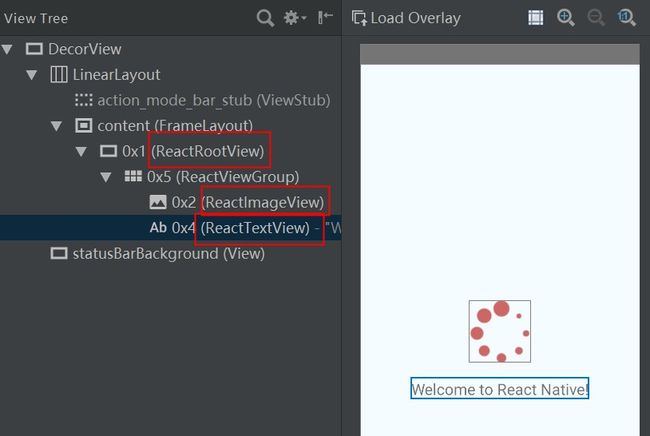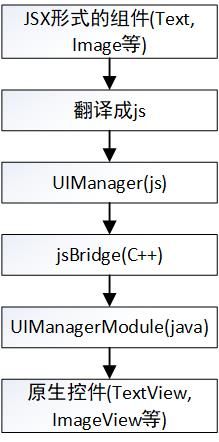此文基于react natve的 September 2018 - revision 5 版本
本人学校毕业后就当了安卓爬坑专业户,3年来总算爬习惯了,不料今年掉进了RN这个天坑,从此开始了我的悲惨人生。。。Anyway,RN的思想还是值得学习的,今天就从Android的角度开始分析一下react native的基础组件如何加载,看看它们与原生控件间的映射关系。
Android端源码浅析
安卓老司机看页面的实现原理,必然首先看Activity,其次看View,RN在安卓端的加载开端也是如此。
以下是截至此文发布前最新的RN官方教程中的例子(RN官方教程和RN源码一样,一日三变,习惯就好) :
public class MyReactActivity extends Activity implements DefaultHardwareBackBtnHandler {
private ReactRootView mReactRootView;
private ReactInstanceManager mReactInstanceManager;
@Override
protected void onCreate(Bundle savedInstanceState) {
super.onCreate(savedInstanceState);
mReactRootView = new ReactRootView(this);
mReactInstanceManager = ReactInstanceManager.builder()
.setApplication(getApplication())
.setBundleAssetName("index.android.bundle")
.setJSMainModulePath("index")
.addPackage(new MainReactPackage())
.setUseDeveloperSupport(BuildConfig.DEBUG)
.setInitialLifecycleState(LifecycleState.RESUMED)
.build();
mReactRootView.startReactApplication(mReactInstanceManager, "MyReactNativeApp", null);
setContentView(mReactRootView);
}
}
从上面的代码中可以看出,承载RN页面显示的也是一个普通的Activity,但setContentView中传入的却是一个特定的ReactRootView,也就是说加载全部在这个ReactRootView中完成。ReactInstanceManager类似于一个代理,承接了IO,通信,布局及其他一些逻辑性操作,下文中还会提到。
public class ReactRootView extends SizeMonitoringFrameLayout
implements RootView, MeasureSpecProvider {
...
@Override
protected void onLayout(boolean changed, int left, int top, int right, int bottom) {
// No-op since UIManagerModule handles actually laying out children.
}
}
上面的代码省略了大部分与本文无关的代码,但也可以看出ReactRootView并没有三头六臂,它只不过是一个很普通的继承自SizeMonitoringFrameLayout(FrameLayout)的控件容器,而且它的onLayout方法是空的,从注释中可以看出子控件的布局在UIManagerModule中实现。
public class UIManagerModule extends ReactContextBaseJavaModule
implements OnBatchCompleteListener, LifecycleEventListener, UIManager {
private final UIImplementation mUIImplementation;
...
@ReactMethod(isBlockingSynchronousMethod = true)
public @Nullable WritableMap getConstantsForViewManager(final String viewManagerName) {
...
// 根据viewManagerName获取ViewManager的映射
return computeConstantsForViewManager(viewManagerName);
}
@Override
public int addRootView(
final T rootView, WritableMap initialProps, @Nullable String initialUITemplate) {
...
// 获取ReactRootView对象的引用,以便于再里面添加View
mUIImplementation.registerRootView(rootView, tag, themedRootContext);
...
}
// 该注解的方法都是可以在js代码中调用的
@ReactMethod
public void createView(int tag, String className, int rootViewTag, ReadableMap props) {
if (DEBUG) {
...
}
// 实现的是reactRootView.addView()
mUIImplementation.createView(tag, className, rootViewTag, props);
}
...
}
同样,UIManagerModule里面也没有太多东西,它主要是用于暴露方法供js调用的,具体实现是由UIImplementation来完成的。被@ReactMethod注解的方法都可以在js代码中被调用到,包括:removeRootView,createView,measure,measureLayout,manageChildren等等,可见子控件的add,measure,layout,remove等操作都是由js调用UIManagerModule相应的方法后完成。
public class UIImplementation {
...
public void createView(int tag, String className, int rootViewTag, ReadableMap props) {
//构建ReactShadowNode
ReactShadowNode cssNode = createShadowNode(className);
ReactShadowNode rootNode = mShadowNodeRegistry.getNode(rootViewTag);
Assertions.assertNotNull(rootNode, "Root node with tag " + rootViewTag + " doesn't exist");
cssNode.setReactTag(tag);
cssNode.setViewClassName(className);
cssNode.setRootTag(rootNode.getReactTag());
cssNode.setThemedContext(rootNode.getThemedContext());
mShadowNodeRegistry.addNode(cssNode);
...
}
...
}
以上就是createView的具体实现,它主要做的是构造了一个ReactShadowNode。
再看看createShadowNode:
protected ReactShadowNode createShadowNode(String className) {
ViewManager viewManager = mViewManagers.get(className);
return viewManager.createShadowNodeInstance(mReactContext);
}
它是通过className获取到ViewManager。问题来了,ViewManager是什么?看它的源码可知它是一个抽象类,从它的源码很难看出它是干什么用的,但一看继承自它的子类就豁然开朗了,它的子类包括ReactTextInputManager,ReactTextViewManager,ReactImageManager,SwipeRefreshLayoutManager,ReactCheckBoxManager,ReactProgressBarViewManager,ReactScrollViewManager等等等。从类名上看,这不就是Android的各种控件吗?查看源码后果然如此。
以ReactTextViewManager为例:
public class ReactTextViewManager
extends ReactTextAnchorViewManager {
...
}
public class ReactTextView extends TextView implements ReactCompoundView {
...
}
它就是对TextView的封装。由此可见js代码最终都映射到了原生的控件上。
我写了一个很简单的RN页面,只有一个Text和一个Image,通过AS上的Layout Inspector可以清晰地看到,最终显示的是封装过的TextView和ImageView。
再回到@ReactMethod注解,它在JavaModuleWrapper中被获取,再通过NativeModuleRegistry被放到了一个映射表里面:
public class JavaModuleWrapper {
...
private void findMethods() {
...
for (Method targetMethod : targetMethods) {
// 获取@ReactMethod注解
ReactMethod annotation = targetMethod.getAnnotation(ReactMethod.class);
...
}
}
}
public class NativeModuleRegistry {
/* package */ Collection getJavaModules(JSInstance jsInstance) {
ArrayList javaModules = new ArrayList<>();
// 生成映射表
for (Map.Entry entry : mModules.entrySet()) {
if (!entry.getValue().isCxxModule()) {
javaModules.add(new JavaModuleWrapper(jsInstance, entry.getValue()));
}
}
return javaModules;
}
}
public class CatalystInstanceImpl implements CatalystInstance {
static {
// jni
ReactBridge.staticInit();
}
@Override
public void extendNativeModules(NativeModuleRegistry modules) {
mNativeModuleRegistry.registerModules(modules);
Collection javaModules = modules.getJavaModules(this);
Collection cxxModules = modules.getCxxModules();
// 将原生方法的映射表传给jsBridge
jniExtendNativeModules(javaModules, cxxModules);
}
// C++的方法
private native void jniExtendNativeModules(
Collection javaModules,
Collection cxxModules);
...
}
最后定位到CatalystInstanceImpl,它内部初始化了ReactBridge(jsBridge),也就是说@ReactMethod注解的方法都放到了一个注册表里面供jsBridge随时调用。
而CatalystInstanceImpl也是在ReactInstanceManager内部实例化的,兜兜转转又回到了开头的ReactInstanceManager,也就是说jsBridge映射到原生控件的逻辑都在它内部实现。
小结
Android端的加载过程大致如下:
- jsBridge映射到
UIManagerModule中有@ReactMethod的方法上; -
UIManagerModule中针对控件的操作由UIImplementation代理,完成控件的add,measure,layout,remove等操作; - 所有控件最终添加到
ReactRootView中,最终由它完成总体的加载并显示。
至此,Android端相关的逻辑已经差不多了,接下来看看在js端又是怎么映射的。
js端源码浅析
先来一段上文中提到过的RN页面的代码:
type Props = {};
class App extends Component {
render() {
return (
Welcome to React Native!
);
}
}
export default App;
css代码不是重点,所以被我省略了,上面只有js和,JSX,一种js的语法糖,所有基础组件都会以JSX的形式置于Component的render方法中。
接下来看看Component是怎么实现的:
const Component = class extends RealComponent {
render() {
const name = RealComponent.displayName || RealComponent.name;
return React.createElement(
name.replace(/^(RCT|RK)/,''),
this.props,
this.props.children,
);
}
};
最终JSX会在React.createElement方法中被翻译成js代码,有兴趣的童鞋可以查查React框架,这里就不多展开了。
现在回到例子代码中的基础组件,以Text为例,看看它的源码:
...
const RCTVirtualText =
UIManager.getViewManagerConfig('RCTVirtualText') == null
? RCTText
: createReactNativeComponentClass('RCTVirtualText', () => ({
validAttributes: {
...ReactNativeViewAttributes.UIView,
isHighlighted: true,
maxFontSizeMultiplier: true,
},
uiViewClassName: 'RCTVirtualText',
}));
const Text = (
props: TextProps,
forwardedRef: ?React.Ref<'RCTText' | 'RCTVirtualText'>,
) => {
return >);
Text的源码不少,对于非专业前端,看起来比较吃力,但也有捷径,从对外暴露点开始找,也就是从module.exports开始,到TextToExport,再到Text,再到RCTVirtualText,最后定位到了UIManager.getViewManagerConfig。
UIManager.getViewManagerConfig = function(viewManagerName: string) {
if (
viewManagerConfigs[viewManagerName] === undefined &&
UIManager.getConstantsForViewManager
) {
try {
viewManagerConfigs[
viewManagerName
] = UIManager.getConstantsForViewManager(viewManagerName);
} catch (e) {
viewManagerConfigs[viewManagerName] = null;
}
}
...
};
看到getConstantsForViewManager,是不是觉得很眼熟?没错,它就是上一板块Android源码中提到的UIManagerModule中的方法,让我们再来回顾一下java源码:
@ReactMethod(isBlockingSynchronousMethod = true)
public @Nullable WritableMap getConstantsForViewManager(final String viewManagerName) {
...
return computeConstantsForViewManager(viewManagerName);
}
private @Nullable WritableMap computeConstantsForViewManager(final String viewManagerName) {
ViewManager targetView =
viewManagerName != null ? mUIImplementation.resolveViewManager(viewManagerName) : null;
if (targetView == null) {
return null;
}
SystraceMessage.beginSection(
Systrace.TRACE_TAG_REACT_JAVA_BRIDGE, "UIManagerModule.getConstantsForViewManager")
.arg("ViewManager", targetView.getName())
.arg("Lazy", true)
.flush();
try {
Map viewManagerConstants =
UIManagerModuleConstantsHelper.createConstantsForViewManager(
targetView, null, null, null, mCustomDirectEvents);
if (viewManagerConstants != null) {
return Arguments.makeNativeMap(viewManagerConstants);
}
return null;
} finally {
SystraceMessage.endSection(Systrace.TRACE_TAG_REACT_JAVA_BRIDGE).flush();
}
}
这个方法的作用就是从缓存中获取ViewManager对象,装入WritableMap后回传给了js,而WritableMap在js中以对象的形式存在。
再回到UIManager,它除了可以调用getConstantsForViewManager,上个板块提到的被@ReactMethod注解的方法诸如removeRootView,createView,measure,measureLayout等等在js中的映射都是由它来调用,也就是说js调用原生控件的映射都由UIManager来完成。
再看一眼UIManager的源码:
const NativeModules = require('NativeModules');
const {UIManager} = NativeModules;
...
module.exports = UIManager;
看来UIManager只不过是对NativeModules的二次封装。写过RN的童鞋对此肯定不陌生,写js和原生通信的相关代码中肯定会用到NativeModules,它是js和原生代码通信的桥梁。
至于NativeModules和C++的交互过程,这里就简单讲一下,NativeModules内部的有一个BatchedBridge(即MessageQueue)的对象:
class MessageQueue {
// js注册的回调,供原生代码调用
_lazyCallableModules: {[key: string]: (void) => Object};
// js调用原生代码请求的缓存列表
_queue: [number[], number[], any[], number];
// js调用原生方法的请求
enqueueNativeCall(
moduleID: number,
methodID: number,
params: any[],
onFail: ?Function,
onSucc: ?Function,
) {
...
// 把请求打包成一个Message,放入缓存列表
this._queue[MODULE_IDS].push(moduleID);
this._queue[METHOD_IDS].push(methodID);
this._queue[PARAMS].push(params);
if (
global.nativeFlushQueueImmediate &&
(now - this._lastFlush >= MIN_TIME_BETWEEN_FLUSHES_MS ||
this._inCall === 0)
) {
var queue = this._queue;
this._queue = [[], [], [], this._callID];
this._lastFlush = now;
// 如果是同步请求,则请求的message立即入列,否则等待flushedQueue()的执行
// 这是一个C++的函数
global.nativeFlushQueueImmediate(queue);
}
}
// 将缓存的请求列表全部入列
flushedQueue() {
this.__guard(() => {
this.__callImmediates();
});
const queue = this._queue;
this._queue = [[], [], [], this._callID];
return queue[0].length ? queue : null;
}
// 注册回调接口
registerCallableModule(name: string, module: Object) {
this._lazyCallableModules[name] = () => module;
}
...
}
它内部保存了js中对外暴露的方法和模块的映射表供jsBridge调用,如果需要调用原生代码中的方法,MessageQueue会将请求封装成一个Message放入一个请求队列,然后触发原生的方法。看着怎么这么像Android中的Handler机制?原因很简单,js执行的线程是独立于原生代码所在的UI线程的,线程间通信最简单的还是类似Handler这样的方式。
小结
RN基础组件映射到原生在js端的表现大致如下:
- JSX形式的RN基础组件首先会被翻译成js代码;
- 组件会在js代码中调用
UIManager相应的方法; - 由
UIManager通过jsBridge映射到原生方法UIManagerModule中;
C++源码浅析
Android端和js端都已经介绍完毕了,就像扁担两头的货物都准备完毕了,就差根扁担了,jsBridge就是这根扁担。
先来看一下与CatalystInstanceImpl.java对应的CatalystInstanceImpl.cpp:
void CatalystInstanceImpl::registerNatives() {
registerHybrid({
// jniExtendNativeModules就是CatalystInstanceImpl.java中那个传入原生方法映射表的native方法
// 它被指向了extendNativeModules方法
makeNativeMethod("jniExtendNativeModules", CatalystInstanceImpl::extendNativeModules),
...
});
JNativeRunnable::registerNatives();
}
void CatalystInstanceImpl::extendNativeModules(
jni::alias_ref::javaobject> javaModules,
jni::alias_ref::javaobject> cxxModules) {
// 注册映射表
moduleRegistry_->registerModules(buildNativeModuleList(
std::weak_ptr(instance_),
javaModules,
cxxModules,
moduleMessageQueue_));
}
可见CatalystInstanceImpl的这部分代码就是用来注册原生方法的映射表的。
再来看看js中调用C++的方法nativeFlushQueueImmediate,以下代码位于JSIExecutor.cpp中:
runtime_->global().setProperty(
*runtime_,
"nativeFlushQueueImmediate",
Function::createFromHostFunction(
*runtime_,
PropNameID::forAscii(*runtime_, "nativeFlushQueueImmediate"),
1,
[this](
jsi::Runtime&,
const jsi::Value&,
const jsi::Value* args,
size_t count) {
if (count != 1) {
throw std::invalid_argument(
"nativeFlushQueueImmediate arg count must be 1");
}
// 调用已注册的原生模块
callNativeModules(args[0], false);
return Value::undefined();
}));
以下代码位于JsToNativeBridge.cpp中,它以委托的形式存在,执行上述代码中的callNativeModules:
void callNativeModules(
JSExecutor& executor, folly::dynamic&& calls, bool isEndOfBatch) override {
...
for (auto& call : parseMethodCalls(std::move(calls))) {
// 执行已注册的原生模块中的方法
m_registry->callNativeMethod(call.moduleId, call.methodId, std::move(call.arguments), call.callId);
}
...
}
最后殊途同归都到了ModuleRegistry.cpp:
// 注册原生模块
void ModuleRegistry::registerModules(std::vector> modules) {
...
}
// 执行原生模块的方法
void ModuleRegistry::callNativeMethod(unsigned int moduleId, unsigned int methodId, folly::dynamic&& params, int callId) {
...
modules_[moduleId]->invoke(methodId, std::move(params), callId);
}
至此,一条完整的映射链已经全部讲完。
总结
本文以一般看源码的顺序来展开,依次解读了Android端,js端和C++的源码,分析了RN基础组件是如何一步步地映射成为原生控件的整个过程,展示了一条完整地映射链条。
最后整理一下整个映射的链条:
以下是一些常用的rn组件与Android原生控件之间的对应关系:
- Text -> TextView
- Image -> ImageView
- TextInput -> EditText
- CheckBox -> AppCompatCheckBox
- RefreshControl -> SwipeRefreshLayout
- ScrollView -> ScrollView
- Slider -> SeekBar
- Switch -> SwitchCompat



